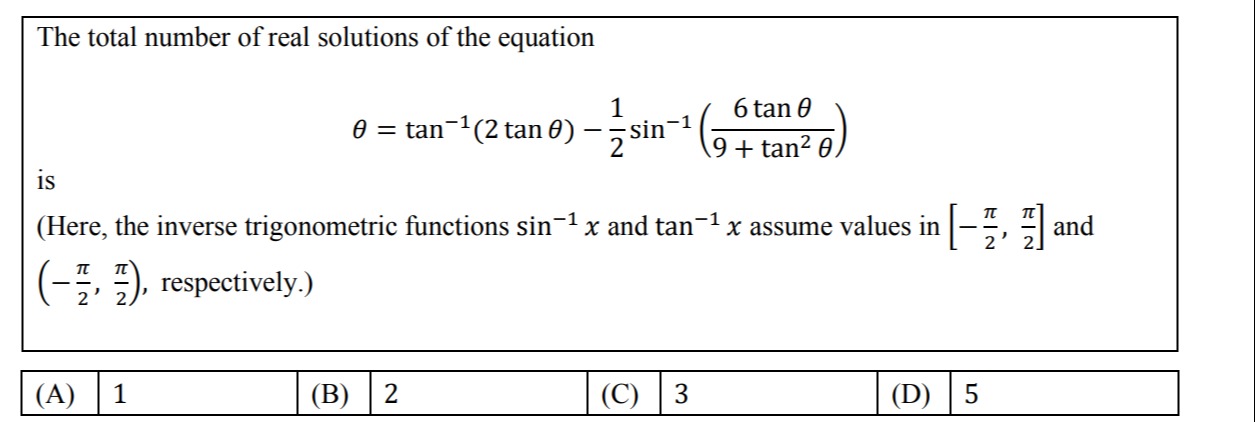Question
Question: The total number of real solutions of the equation $\theta = \tan^{-1}(2 \tan \theta) - \frac{1}{2}...
The total number of real solutions of the equation
θ=tan−1(2tanθ)−21sin−1(9+tan2θ6tanθ)
is
(Here, the inverse trigonometric functions sin−1x and tan−1x assume values in [−2π,2π] and (−2π,2π), respectively.)

1
2
3
5
3
Solution
Let t=tanθ. The given equation is θ=tan−1(2t)−21sin−1(9+t26t) Let t=3tanϕ. Then 9+t26t=9+(3tanϕ)26(3tanϕ)=9(1+tan2ϕ)18tanϕ=1+tan2ϕ2tanϕ=sin(2ϕ). The term 21sin−1(9+t26t) becomes 21sin−1(sin(2ϕ)).
We need to consider different intervals for ϕ based on the range of sin−1x, which is [−2π,2π]. sin−1(sin(2ϕ))=2ϕ if 2ϕ∈[−2π,2π], i.e., ϕ∈[−4π,4π]. This corresponds to t=3tanϕ∈[3tan(−4π),3tan(4π)]=[−3,3].
Case 1: t∈[−3,3]. In this case, 21sin−1(9+t26t)=21(2ϕ)=ϕ. Since t=3tanϕ, ϕ=tan−1(t/3). The equation becomes θ=tan−1(2t)−tan−1(t/3). We use the formula tan−1x−tan−1y=tan−1(1+xyx−y) for xy>−1. Here x=2t,y=t/3. xy=2t2/3. Since t is real, t2≥0, so 2t2/3≥0>−1. The formula is valid. θ=tan−1(1+(2t)(t/3)2t−t/3)=tan−1(1+2t2/35t/3)=tan−1(3+2t25t). Since t=tanθ, we have tanθ=tan(tan−1(3+2t25t)). This implies t=3+2t25t. t(3+2t2)=5t 3t+2t3=5t 2t3−2t=0 2t(t2−1)=0 2t(t−1)(t+1)=0. The possible values for t are 0,1,−1. All these values are in the interval [−3,3].
If t=0, tanθ=0. θ=nπ. Substitute into the original equation: nπ=tan−1(0)−21sin−1(0)=0−0=0. nπ=0⟹n=0. So θ=0 is a solution.
If t=1, tanθ=1. θ=nπ+4π. Substitute into the original equation: nπ+4π=tan−1(2)−21sin−1(106)=tan−1(2)−21sin−1(53). We know tan−1(2)−21sin−1(53)=tan−1(2)−tan−1(31)=tan−1(1+2⋅1/32−1/3)=tan−1(5/35/3)=tan−1(1)=4π. So nπ+4π=4π⟹nπ=0⟹n=0. So θ=4π is a solution.
If t=−1, tanθ=−1. θ=nπ−4π. Substitute into the original equation: nπ−4π=tan−1(−2)−21sin−1(10−6)=−tan−1(2)−21(−sin−1(53))=−tan−1(2)+21sin−1(53). We know tan−1(2)−21sin−1(53)=4π. So −tan−1(2)+21sin−1(53)=−(tan−1(2)−21sin−1(53))=−4π. So nπ−4π=−4π⟹nπ=0⟹n=0. So θ=−4π is a solution. From Case 1, we have three solutions: θ=0,4π,−4π.
Case 2: t>3. If t>3, then tanϕ>1, so ϕ∈(4π+kπ,2π+kπ) for integer k. We need to evaluate sin−1(sin(2ϕ)). The range of sin−1 is [−2π,2π]. If k=0, ϕ∈(4π,2π). Then 2ϕ∈(2π,π). sin−1(sin(2ϕ))=π−2ϕ. 21sin−1(sin(2ϕ))=2π−ϕ=2π−tan−1(t/3). The equation is θ=tan−1(2t)−(2π−tan−1(t/3))=tan−1(2t)+tan−1(t/3)−2π. Since t>3, 2t>6 and t/3>1. x=2t>0,y=t/3>0. xy=2t2/3>2(32)/3=6>1. Use tan−1x+tan−1y=π+tan−1(1−xyx+y) for x>0,y>0,xy>1. tan−1(2t)+tan−1(t/3)=π+tan−1(1−(2t)(t/3)2t+t/3)=π+tan−1(1−2t2/37t/3)=π+tan−1(3−2t27t). The equation is θ=π+tan−1(3−2t27t)−2π=2π+tan−1(3−2t27t). Since t=tanθ, tanθ=tan(2π+tan−1(3−2t27t))=−cot(tan−1(3−2t27t))=−tan(tan−1(3−2t27t))1=−3−2t27t1=7t2t2−3. So t=7t2t2−3. 7t2=2t2−3 5t2=−3 t2=−3/5. This has no real solutions for t. If k=1, ϕ∈(45π,23π). Then 2ϕ∈(25π,3π). sin(2ϕ)=sin(3π−2ϕ). 3π−2ϕ∈(0,2π). sin−1(sin(2ϕ))=3π−2ϕ. 21sin−1(sin(2ϕ))=23π−ϕ=23π−tan−1(t/3). Equation: θ=tan−1(2t)−(23π−tan−1(t/3))=tan−1(2t)+tan−1(t/3)−23π. Since t>3, tan−1(2t)+tan−1(t/3)=π+tan−1(3−2t27t). Equation: θ=π+tan−1(3−2t27t)−23π=tan−1(3−2t27t)−23π. t=tan(tan−1(3−2t27t)−23π)=cot(tan−1(3−2t27t))=7t3−2t2. 5t2=−3, no real solutions. For other values of k≥1, 2ϕ will be in an interval where sin−1(sin(2ϕ)) leads to similar results.
Case 3: t<−3. If t<−3, then tanϕ<−1, so ϕ∈(−2π+kπ,−4π+kπ) for integer k. If k=0, ϕ∈(−2π,−4π). Then 2ϕ∈(−π,−2π). sin(2ϕ)=sin(−π−2ϕ). −π−2ϕ∈(−2π,0). sin−1(sin(2ϕ))=−π−2ϕ. 21sin−1(sin(2ϕ))=−2π−ϕ=−2π−tan−1(t/3). Equation: θ=tan−1(2t)−(−2π−tan−1(t/3))=tan−1(2t)+tan−1(t/3)+2π. Since t<−3, 2t<−6 and t/3<−1. x=2t<0,y=t/3<0. xy=2t2/3>2(−3)2/3=6>1. Use tan−1x+tan−1y=−π+tan−1(1−xyx+y) for x<0,y<0,xy>1. tan−1(2t)+tan−1(t/3)=−π+tan−1(3−2t27t). Equation: θ=−π+tan−1(3−2t27t)+2π=tan−1(3−2t27t)−2π. t=tan(tan−1(3−2t27t)−2π)=−cot(tan−1(3−2t27t))=7t2t2−3. 5t2=−3, no real solutions. If k=1, ϕ∈(2π,43π). Then 2ϕ∈(π,23π). sin(2ϕ)=sin(π−2ϕ). π−2ϕ∈(−2π,0). sin−1(sin(2ϕ))=π−2ϕ. 21sin−1(sin(2ϕ))=2π−ϕ=2π−tan−1(t/3). Equation: θ=tan−1(2t)−(2π−tan−1(t/3))=tan−1(2t)+tan−1(t/3)−2π. Since t<−3, tan−1(2t)+tan−1(t/3)=−π+tan−1(3−2t27t). Equation: θ=−π+tan−1(3−2t27t)−2π=tan−1(3−2t27t)−23π. t=tan(tan−1(3−2t27t)−23π)=cot(tan−1(3−2t27t))=7t3−2t2. 7t2=3−2t2 9t2=3 t2=1/3. t=±1/3. These values are not in the interval t<−3. For other values of k≤−1, 2ϕ will be in an interval where sin−1(sin(2ϕ)) leads to similar results.
The only real solutions are obtained when t∈[−3,3], which gives t=0,1,−1. These correspond to θ=0,4π,−4π. We verified that these three values satisfy the original equation. The total number of real solutions is 3.
